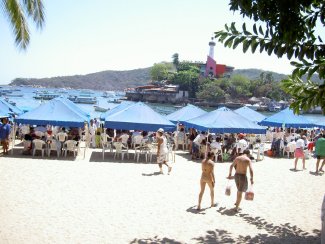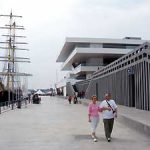 I was walking on the Costera Miguel Alemn, Acapulco’s main thoroughfare, with a colleague who had last visited the city in the early 1960s when he remarked, “I can’t believe how Acapulco now looks! When I was last here all I remember is the grit, annoying peddlers, polluted beaches and unsafe streets. Look at it now!” He continued, “Now what some travellers once described as ‘a dazzling resort spreading on the green towering Sierra Madre del Sur mountains, sloping downward to the blue warm waters of a bay’, rings true.”
I was walking on the Costera Miguel Alemn, Acapulco’s main thoroughfare, with a colleague who had last visited the city in the early 1960s when he remarked, “I can’t believe how Acapulco now looks! When I was last here all I remember is the grit, annoying peddlers, polluted beaches and unsafe streets. Look at it now!” He continued, “Now what some travellers once described as ‘a dazzling resort spreading on the green towering Sierra Madre del Sur mountains, sloping downward to the blue warm waters of a bay’, rings true.”
My colleague might have been somewhat exaggerating, but Acapulco whose fame as a vacation mecca has returned is today truly a delightful playground. After a billion dollar investments in the city’s infrastructure there has arisen a new Acapulco. The pestering peddlers are nowhere in sight. Landscaping and other beautification projects have made the city much more appealing to visitors. The sands have been cleaned, the streets have been made much safer, the city’s infrastructure and roads have been improved and a new sanitation system has been installed.
Acapulco is situated around a horseshoe shaped bay, considered one of the most beautiful bays in the world, edged by cliffs and hills. At every point there are incredible views of the entire bay, most of the city, and the many beaches within the bay itself. Businessmen have taken advantage of these views and built bars, hilltop discos and restaurants with panoramic view of the bay, giving their customers a delightful setting in which to dine and dance.
 Besides the hundreds of hotels with their thousands of rooms – most located directly on the beach – new hotels and apartment complexes, such as Mundo Imperial, a huge building complex under way, are being planned. Tourism is the resort’s lifeblood. The city, Mexico’s largest seaside resort, attracts annually almost 5 million visitors and at least 80% of Acapulco’s some 2 million inhabitants live off the tourist industry.
Besides the hundreds of hotels with their thousands of rooms – most located directly on the beach – new hotels and apartment complexes, such as Mundo Imperial, a huge building complex under way, are being planned. Tourism is the resort’s lifeblood. The city, Mexico’s largest seaside resort, attracts annually almost 5 million visitors and at least 80% of Acapulco’s some 2 million inhabitants live off the tourist industry.
This face-lift has restored Acapulco’s romantic reputation and jet set image and enhanced its legendary nightlife reputation with its aura of sensuality. During the hours of darkness, the city vibrates with dynamic life, swinging away the whole night. Its neon-lighted luxurious chic nightclubs and discotheques have made it a city that never sleeps, giving it great appeal to the young and many of the rich and famous, making the resort the romance capital of the world.
The tradition of the Hollywood stars’ love affair with Acapulco has a long history. It was the Hollywood stars that put Acapulco on the map. All this began in the 1930s when John Wayne, Johnny Weismuller (Tarzan), Errol Flynn, Frank Sinatra and Roy Rogers, among others, often called in on Acapulco’s still operating Los Flamingos Hotel home. John and Jackie Kennedy, Bill and Hillary Clinton and Elizabeth Taylor and Michael Todd honeymooned amid its sun and sand. Today, Julio Iglesias, Luis Miguel, Sylvester Stallone and Placido Domingo all have homes in this resort that has long been a relaxing place of the stars.
 Like these stars, so many others have been lured by the resort’s seductive appeal. Travellers have written that in this sun and fun city the nightly notes of music drift through the trees, swaying to the soft humid wind, then mingle with the sounds of the ocean, the scent of perfuming flowers and the murmur of lovers – a sensuality undoing one’s inhibitions. They say that for lovers and others who want to enjoy life there is no resort in the world that can compare to this Mexican Riviera – a beach resort par excellence.
Like these stars, so many others have been lured by the resort’s seductive appeal. Travellers have written that in this sun and fun city the nightly notes of music drift through the trees, swaying to the soft humid wind, then mingle with the sounds of the ocean, the scent of perfuming flowers and the murmur of lovers – a sensuality undoing one’s inhibitions. They say that for lovers and others who want to enjoy life there is no resort in the world that can compare to this Mexican Riviera – a beach resort par excellence.
To appreciate the changes and the allurement which have drawn the affluent to what the Acapulcans call the “Mother of all Mexican Resorts” and at other times ‘Pearl of the Pacific’, we decided to tour the spread-out city – its main part stretching for 23 km (14 mi) around a series of picturesque bays, coves and cliffs, edging 23 fine beaches.
 We began by driving along the Costera Aleman through what is called the ‘Golden Zone’ – a long stretch of mostly luxury hotels, modern shopping plazas, crowded handicraft markets, a world of restaurants, glitzy discotheques and intimate nightclubs. Westward, past this affluent zone, we entered the old town that the budget traveller calls home.
We began by driving along the Costera Aleman through what is called the ‘Golden Zone’ – a long stretch of mostly luxury hotels, modern shopping plazas, crowded handicraft markets, a world of restaurants, glitzy discotheques and intimate nightclubs. Westward, past this affluent zone, we entered the old town that the budget traveller calls home.
After crossing the heart of the old city, we came to La Quebrada, the top tourist attraction in Acapulco, that is a sheer 41 m (135 ft) high cliff from which native divers fling themselves down into the sea. In a breathtaking performance, especially in the death defying night dives when the divers carrying flaming torches plunge into the waters below – a spectacular show to see.
We watched them during the day dive at 97 km (60 mi) an hour, hitting the water in three seconds. The water is usually some 3 m (10 ft) deep and the divers must wait for a surging wave to crest before taking the plunge. Even though to the onlooker the diving spectacle seems death defying, no one has been hurt since this exhibition for tourists began in 1934.
It is best to see these dives from La Perla Restaurant in the El Mirador Hotel built into the cliffs above. However if you are one who does not like climbing stairs, avoid the restaurant. To have a good vantage point you must descend then climb some 100 steps – just join the crowds on the outside.
 Back at the Zocalo, the town’s main square, teeming with activity, we roamed for a while through the Plaza admiring its quaint tree-lined walkways. However, what intrigued us most was this Mexican city’s most unusual blue and white church with its twin gold-tiled towers and a domed roof. Strangely, more than a Christian House of Worship, it carried the characterization of a mosque.
Back at the Zocalo, the town’s main square, teeming with activity, we roamed for a while through the Plaza admiring its quaint tree-lined walkways. However, what intrigued us most was this Mexican city’s most unusual blue and white church with its twin gold-tiled towers and a domed roof. Strangely, more than a Christian House of Worship, it carried the characterization of a mosque.
A few feet from the Zocalo, we stopped awhile at the Plaza Sor Juana Ines de la Cruz to examine the historic house known as Posada del Recuerdo, the oldest home in Acapulco, then walked to the nearby Pozo de la Nacion neighbourhood, the oldest quarter in the city. Here, after touring this quaint small area with its Andalusian flair, we along with hundreds of the city’s inhabitants and a sprinkling of tourists, watched a fine folkloric group perform. It gave us another taste of Acapulco’s revitalization and innumerable tourist attributes in this most dazzling tourist centre in Mexico.
 It was late in the day when we ended our tour, stopping on a high point at the sprawling Las Brisas luxury hotel complex. As I stood in the midst of flowering hibiscus and colourful pinkish structures and gazed at the deep hues of the sea contrasting with the vibrant colours of the surrounding tropical vegetation, the words of a beautiful tourist official standing beside me sounded so true when she said: “They say that Acapulco’s natural beauty is so perfect that it was designed by God.”
It was late in the day when we ended our tour, stopping on a high point at the sprawling Las Brisas luxury hotel complex. As I stood in the midst of flowering hibiscus and colourful pinkish structures and gazed at the deep hues of the sea contrasting with the vibrant colours of the surrounding tropical vegetation, the words of a beautiful tourist official standing beside me sounded so true when she said: “They say that Acapulco’s natural beauty is so perfect that it was designed by God.”
IF YOU GO
Facts About Acapulco:
1) Acapulco has an international airport and the new superhighway No. 95, connects the resort to Mexico City, but the toll is sky high – takes less than 4 hours driving.
2) Getting around town is easy by taxi, bus – cost about 40 cents – horse-drawn carriage or rented autos. Small cars, fully insured with unlimited mileage, rent for about $65. per day. It is easy to drive in Acapulco – drivers seem to obey the law.
3) Acapulco, called by some the ‘playground of the world’, offers besides breathtaking scenery, pristine beaches, deluxe accommodation, all types of sport activities, including four manicured 18-hole Gulf courses and one 9-hole course.
4) Make sure to visit the late Dolores Olmedo’s home where the famous painter Diego Rivera covered the entire outside wall with an Aztec mural of mosaic tiles and stones – a piece of art, unique in Acapulco.
5) Acapulco offers a world of culinary delights. Besides the peoples’ restaurants near the Zocalo offering fine dinners for around $10., there are some 160 classy eating places like the Zibu serving the best in Mexican and international dishes.
6) When in Acapulco, for those historically minded, a visit to the nearby Tehuacalco Archaeological Zone is fulfilling journey.
6) When you leave Mexico there is a ‘Departure Tax’ of about $18.00.
Some of the Sites Not Mentioned – Worth a Visit:
Fort San Diego, newly renovated and housing Acapulco’s historic museum; House of Masks, a magic world of fantasy; Puerto Marquez Beach with its tranquil bay and unforgettable scenery; Caleta & Caletilla Beaches, two of the most tranquil and beautiful beaches in the heart of Acapulco; Coyuca Lagoon, one of the most important natural attractions in Acapulco; and Isla Roqueta, from Caleta Beach a glass-bottomed boat crossing to Isla Roqueta allows one to admire the undersea life.
Where to Stay in Acapulco:
Acapulco has hotels to satisfy all tastes. In the old city, there are abodes that offer rooms at less than ($10.) per night. At the upper level, the city has some of the top luxury hotels like Las Brisas, a luxurious hotel for the affluent; the Fairmont Acapulco Princess Hotel, towering upward like a grand Aztec pyramid; and for those who love history, Los Flamingos Hotel is the place to stay. Situated high on a cliff, it is cooled by the sea breeze and offers a view of spectacular sunsets.
Note: All prices quoted are in US dollars – about 15 pesos to a US dollar.
For Further Information, Contact:
In Canada contact the Mexican Tourism Board – 2 Bloor St. West, Suite 1502, Toronto, Ontario M4W 3E2. Tel: (416) 925 0704. Fax: (416) 925 6061.
E-mail: toronto@visitmexico.com
Also Toll free number: 1-800-44 MEXICO.
Web: www.visitmexico.com; in the U.S.A. 375 Park Avenue, Floor 19, Suite 1905, New York, NY 10152, USA. Tel: (212) 308 2110. Fax: (212) 308 9060. E-mail: newyork@visitmexico.com
Also, see website: www.acapulco.com for information and reservations: Tel: from the USA / Canada: 1 888 514 2137; from Mexico: Tel: 01 800 674 9434










Leave a Reply